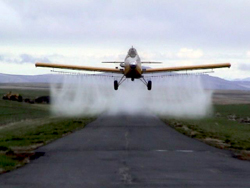Business Links
Nat'l Ag Av Assoc NTSB Database N# Database Chemical Labels Worker Protection Containment Rules Ag in the Classroom Far West Ag Assoc.Weather
NOAA Weather Weather Underground Meso West NW Ag Weather Joseph OR WeatherIdaho
ID Ag Dept ID D.O.T. Boise FSDO Salt Lake FSDO U of I Extension Food Producers IDOregon
OR Ag Dept OR D.O.T. Portland FSDO OSU Extension Food & ShelterWashington
WA Ag Dept WA D.O.T. Spokane FSDO Seattle FSDO WSU Extension Friends of Farm …Montana
MT Ag Dept MT D.O.T. Helena FSDO MSW Extension
Frequently Asked Questions
What is a crop duster?
A. A.K.A. aerial applicators, A.K.A. ag pilots. Ag products delivered on crops used to only be available in a "dust" form; therefore the pilot who distributed these crop protectors became known as "Crop Dusters".
"Aerial application accounts for almost 25% of crop protection applications and nearly 100% of forest protection applications. Aerial application is often the safest, fastest, most efficient, and most economical way to get the job done." - National Agricultural Aviation Association
Is aerial application (crop dusting) safe?
A. Today's crop spraying planes are equipped with mapping technology that makes it is possible to pinpoint exact areas to be sprayed and assures even distribution; thus protecting the crop and the environment.
Aerial application vs ground (truck) application?
A. "An airplane or helicopter may accomplish
more in one hour than ground equipment can in one day. This means less fuel
used, less air pollution and no soil compaction. The aerial application
industry appreciates the importance of ground sprayers as a tool needed in
agriculture when aerial or chemigation work cannot be done. In fact, many
aerial application businesses today use both aircraft and ground rigs to
make crop protection product applications. "
- Andrew D. Moore, Executive Director,
National Agricultural Aviation Association
Who regulates crop dusters?
A: "Almost everybody." Individual states regulate the pesticide application certification and certain loading and storage containment requirements. The federal agencies include FAA (Federal Aviation Administration), EPA (Environmental Protection Agency), USDA (United States Department of Agriculture), FDA Food and Drug Administration), OSHA (Occupational Safety and Health Administration), etc. - www.agaviation.com
Are ag planes a threat to our homeland security?
A. "Many security experts in government and in the private sector are in agreement with the NAAA position that ag aviation aircraft represent a poor option as potential vehicles for terrorist attacks." - Agricultural Aviation Security document published by NAAA. Read full article.
